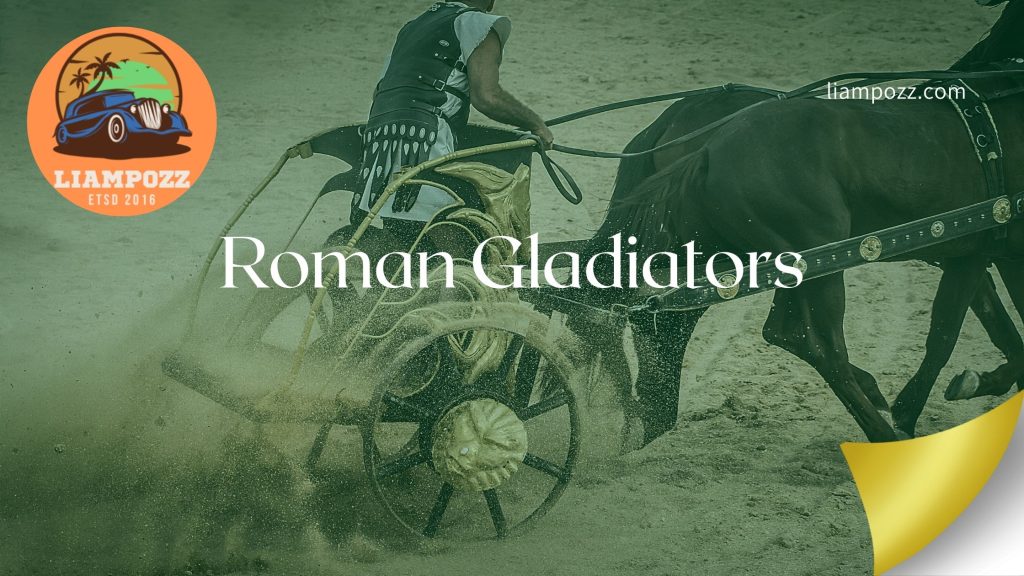Always ask if it’s completely free or not, much of it is an immediate contradiction of the traditional image the majority of us have of the ancient world. One of the things that I love about soccer is it truly is a lovely game. There are a few other practical things. One reason it’s somewhat nerve-wracking to cross the street on foot is because of the crazy driving in Italy. See, it’s all an issue of perspective.
You will realize antique sculptures, renaissance art by greats including Michelangelo, maps and a lot more. If a Roman statue is idealized, it is most likely a statue of one of many Roman emperors, who were regarded as divinities. Greek statues mean to concentrate on athleticism and mythology. Additionally, People were some sort of costume like helmet, shield and some other heavy clothes to safeguard themselves. Gladiator it is quite a fine movie.
From Sculptures to Gladiator Films

The stink was just a little portion of it, however. There’s no deficiency of dangerous places and the unfortunate list appears to be growing. More than that it is a day off for many folks. Obviously based on where you’re staying the quantity of time that it requires to get from A to B will be different. You’re operating outside the time and energy demands of your everyday life, for one. It’s dangerous work in a location where law is thin. Perhaps your experience is very similar to his.
Life’s Risks and Rewards
In the area of competitive athletics and in life it’s important to bear in mind there are things we can and can’t control. You’re watching the movie of life and are so involved in your version of the story and the edition of the story you’ve been told, that you’re missing the little mistakes that show you that it isn’t all what it appears to be. 1 day you may be living a lovely life and the following day you might be dead. Plassat’s own life was threatened. Only a famed death is going to do.
The Game of Life: Perceptions and Imperfections

Take into consideration the players who never have a play off since they feel that every player and coach deserves their very best! In the present time, once the game stops being a game, when they realize they aren’t bullet proof, they are ready to discover it is irrelevant whether they would care to play hero or not. Roman games are generally sorted into the. The game began to get some traction and we chose to set a huge focus on it while we continue to explore different areas in blockchain development. Gladiator games were fought for centuries, perhaps so long as a millennium. The match was billed as the very best player on the planet against the very best team on earth.
The World of Gladiator Games
Unless you anticipate turning into a gladiator whilst you’re there. Gladiator is a rather fine movie I will recommend folks to watch it. Caesar was free to select. Rome had ever been the seat of the Pope. By the start of the very first century BC, the ancient city of Rome has slowly become an enormous metropolis featuring all the probable issues deriving from that truth.

If you’re curious, you must dive into the topic matter yourself. Not many barriers in place make it simple to get lots of clean shotsno tourist removing’ apps needed! Then, obviously, there were the rats, lots and plenty of themand they didn’t mind a little Tosher for afternoon tea.
Who was the greatest gladiator in Roman history?
When it comes to the greatest gladiator in Roman history, there can be no debate – it’s Spartacus. The Thracian slave-turned-rebel managed to lead an uprising against the mighty Roman Empire and came very close to winning. His story is one of heroism and defiance in the face of overwhelming odds, and he remains a legendary figure to this day.

Spartacus was born into slavery in Thrace in the early years of the 1st century BC. He initially worked as a shepherd, but was eventually sold into slavery and sent to Italy. There, he was trained as a gladiator in the brutal and deadly arenas of Rome.
In 73 BC, Spartacus and some fellow gladiators managed to escape from their training school, and quickly formed a rebel army. They soon began to wage a war against the Roman Empire, raiding villages and freeing slaves. The rebellion quickly gathered momentum, and by 71 BC Spartacus had an army of over 70,000 men.
The Roman army was initially unable to put down the rebellion, and Spartacus even managed to defeat a consular army. However, the Romans eventually managed to crush the rebellion, with the help of Crassus. Spartacus himself was killed in battle, and his followers were either killed or captured.
Who won the most gladiator fights?
In the Roman Republic, the gladiator contests were extremely popular. The gladiators were men who fought each other in mortal combat for the entertainment of the spectators. The contests were often brutal and bloody, and the gladiators were often very skilled fighters.

There were many different types of gladiator contests, and each type had its own champions. The most popular type of contest was the venatio, or animal hunt. In a venatio, gladiators fought against wild animals. The most famous champion of the venatio was a gladiator named Secutor. Secutor was so successful in his animal hunts that he became the only gladiator to be granted the privilege of having a public statue erected in his honor.
Another popular type of gladiator contest was the pugilatus, or boxing match. The most famous champion of the pugilatus was a gladiator named Murmillo. Murmillo was so successful in his boxing matches that he became a crowd favorite. He was eventually matched against a gladiator named Secutor. The match between Murmillo and Secutor was a bloody one, and both fighters ended up being seriously injured. Murmillo, however, was the victor, and he was crowned the new champion of the pugilatus.
What did Roman gladiators fight for?
The world of ancient Rome is replete with fascinating stories of valor, spectacle, and bloodshed, and at the center of this drama were the Roman gladiators. These skilled combatants captivated the hearts and minds of countless spectators as they clashed in epic battles within the confines of the Colosseum and other amphitheaters.
Entertainment
One of the primary reasons for the existence of gladiatorial combat in ancient Rome was entertainment. Roman society had an insatiable appetite for spectacles, and the sight of gladiators engaging in life-and-death struggles was a form of amusement for the masses. These battles were often organized by wealthy citizens, politicians, or emperors to gain popularity and curry favor with the public.
Glory and Fame
For some gladiators, the arena offered a chance at glory and fame. Although they were typically slaves, prisoners of war, or criminals, successful gladiators could earn renown and admiration from the crowds. If they survived numerous battles, they might even earn their freedom and be celebrated as heroes. The path to glory was perilous, but it was a possibility for those who excelled in combat.
Financial Gain
While many gladiators fought against their will, some chose this path for the potential financial rewards. Prominent gladiators could earn substantial sums of money, either through prize winnings or by gaining the favor of wealthy patrons who might sponsor them. This financial incentive was particularly appealing to individuals who saw few other opportunities for economic advancement.
Freedom
Perhaps the most compelling motivation for some gladiators was the prospect of freedom. The “auctorati,” gladiators who volunteered for combat, could negotiate terms with their lanista (the owner of the gladiatorial school) that included the possibility of earning their freedom after a certain number of victories. This promise of liberation was a powerful incentive for some to enter the arena.
Punishment and Redemption
For others, gladiatorial combat was a form of punishment or a path to redemption. Criminals and prisoners of war were often sentenced to become gladiators, and their battles were seen as a way to atone for their crimes or serve their sentences. Winning battles in the arena could potentially lead to a pardon or a lighter sentence.
Roman gladiators fought for a variety of reasons, including entertainment, the pursuit of glory and fame, financial gain, the hope of freedom, and as a form of punishment or redemption. Their stories, though filled with hardship and danger, continue to capture our imagination and provide a glimpse into the complex motivations that drove these iconic warriors to step into the arena, where they would either meet their end or emerge as legends of their time.
Why did Romans stop gladiator fights?
Gladiator fights were hugely popular in Ancient Rome, but they eventually stopped happening. Here’s why.
- The first gladiator fight in Rome was in 264 BC. They became hugely popular, and by the end of the Roman Republic there were around 4,000 gladiators in Rome.
- Gladiator fights were used to entertain the masses and to keep them happy. They also served as a way to keep the population under control – if people were unhappy, the authorities could always put on a gladiator fight to distract them.
But over time, the popularity of gladiator fights waned. There were a few reasons for this.
- Firstly, the fights became more and more brutal. People started to find them less entertaining and more disturbing.
- Secondly, the rich started to use gladiator fights as a way to show off their wealth. This made the fights less accessible to the general public.
- Thirdly, the Romans started to lose interest in the gladiator games.
The decline of the gladiator games was mainly due to three factors
First, the fights became more and more brutal, which made them less entertaining and more disturbing. For example, in the early days of the games, the gladiators would often fight with wooden swords, but by the end of the games, they were using metal swords and other deadly weapons. This made the games less enjoyable to watch.
Second, the rich started to use the gladiator games as a way to show off their wealth. This made the games less accessible to the general public, as the rich could afford to buy better seats and enjoy a better view of the action.
Thirdly, the Romans started to lose interest in the gladiator games. This was partly due to the fact that the games had become less entertaining, but it was also because of the growing popularity of other forms of entertainment, such as theatre and chariot racing.
Things You May Not Know About Roman Gladiators
Roman gladiators were a fascinating and iconic part of ancient Roman culture. Here are ten things you may not know about them:
- Origins of Gladiatorial Combat: Gladiatorial combat likely originated from Etruscan funeral games, where combatants would fight to honor the deceased. The Romans adopted and adapted this tradition for their own entertainment.
- Varied Types of Gladiators: There were various types of gladiators, each with their own unique weapons and armor. Some popular types include the Retiarius (armed with a net and trident), the Secutor (heavily armored and equipped with a sword), and the Murmillo (wearing a fish-shaped helmet and armed with a sword and shield).
- Training Schools: Gladiators were trained in specialized schools called “ludi.” These schools were often owned by wealthy individuals or lanistae who saw potential profit in the gladiators’ fights.
- Legal Status: Gladiators were typically slaves, prisoners of war, or criminals. However, some individuals chose to become gladiators voluntarily in hopes of fame and fortune.
- Fighting Styles and Tactics: The outcome of a gladiatorial contest often depended on the fighting styles and tactics employed. For example, the Retiarius relied on agility and precision, while the heavily armored Murmillo focused on defense and power.
- Fame and Fortune: Successful gladiators could achieve celebrity status and gain substantial wealth. They often had fan followings and could even endorse products, similar to modern-day athletes.
- Death Rates: While gladiators did sometimes die in the arena, they were expensive investments for their owners. Therefore, it was not in their owners’ interest for them to die frequently. Medical care and training were provided to keep them fit for battle.
- Female Gladiators: Although less common, there were female gladiators known as “gladiatrices.” They faced similar training and combat as male gladiators and often fought in women-only contests.
- Gladiatorial Games as Political Tools: Emperors and politicians often used gladiatorial games to gain popularity and support among the Roman populace. Spectacular and elaborate games were held during various celebrations and events.
- End of Gladiatorial Combat: As the Roman Empire declined, the popularity of gladiatorial combat waned. The practice eventually fell out of favor and was officially banned by Emperor Honorius in 399 AD.
Roman gladiators left a significant mark on history, not just as fighters but also as symbols of Roman culture, entertainment, and society. Their stories continue to captivate our imagination and provide insight into the ancient world.
Conclusion
In conclusion, Roman gladiators were a complex and multifaceted aspect of ancient Roman culture. These warriors, who fought in arenas for the entertainment of the masses, were more than just combatants; they represented a unique blend of tradition, politics, and entertainment.
From their diverse fighting styles and training to the different types of gladiators, their history is rich and intriguing. While the gladiatorial games may have initially emerged from somber funeral rituals, they evolved into grand spectacles that showcased bravery, skill, and even celebrity. The lives of gladiators, their fates in the arena, and their eventual decline as the Roman Empire fell all contribute to a captivating chapter in the annals of history, offering us a glimpse into the complexities of ancient Roman society.





